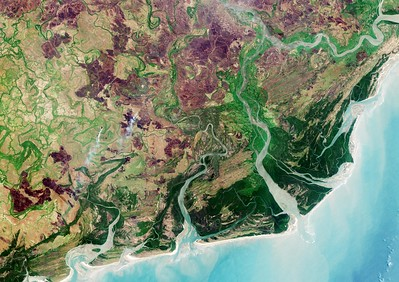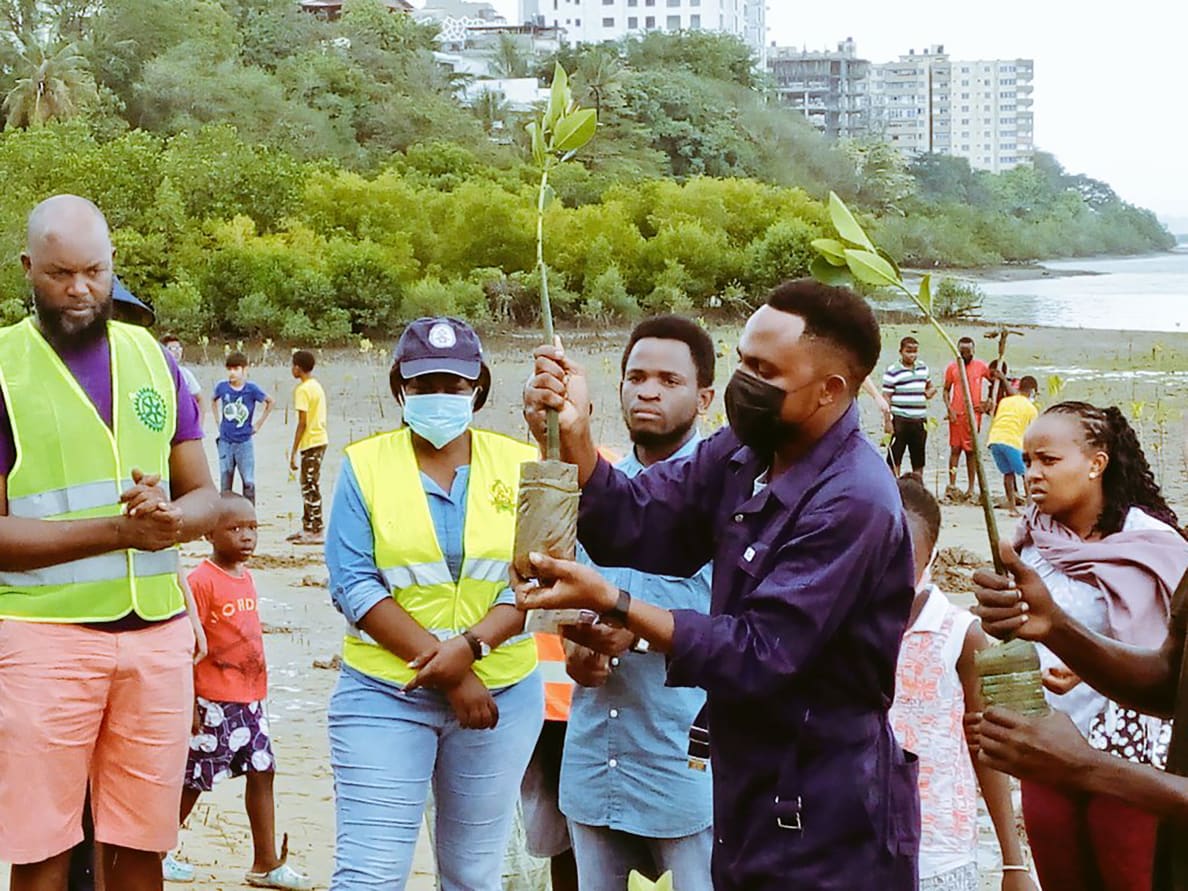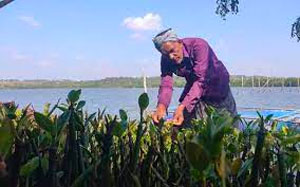MAP Website en Español haga clic aqui FEATURED STORY How Sundarbans’ Mangrove Man travelled a green journey

INDIA – The significance of the mangrove plantation was highlighted during the cyclone Aila that had swept the Sundarbans which comes under South 24 Parganas. Umashankar Mandal, often known as the Mangrove Man, teaches geography at Jangipur High School in Murshidabad and lives on the remote islands of the Sundarbans. His efforts to restore ecological balance in the Sundarbans through mangrove plantation and to raise public awareness about the benefits of mangrove trees have earned him the title of “Mangrove Man” Sharing his journey with The Sunday Guardian, Umashankar recalled, “I started my journey in 2009 when cyclone Aila hit the island. The idea came up when we saw that the people, homes, and animals had all sunk and drifted away. We started a relief campaign for the people, many people from Kolkata and nearby areas came to help us. Again, when I visited the Sundarbans in July, I noticed that the environment (landscapes and various types of mangrove trees) had been destroyed. We began working on restoring the ecological balance by engaging almost 220 villagers who used to collect Avicennia alba (plant) seeds. All their efforts and the plantation drive have helped to reduce carbon emissions, soil erosion, and so forth. At present, including the areas of Kakmari, Sonaga, Kumirmari and Chorghiri, we have planted 740,500 trees. We want to get people involved in planting more trees. READ MORE GLOBAL International Day of Forests

GLOBAL – Save the date: International Day of Forests 2022 21 March – a live celebration for the International Day of Forests as a high-level panel discusses “The Role of Forests in Ensuring Sustainable Consumption and Production”, direct from the Swedish Pavilion at EXPO 2020 in Dubai. Today the world is facing unprecedented challenges, with climate change being among the most pressing of all. These challenges threaten the well-being of people and nature, and call for immediate action to develop innovative and creative solutions that set the world on a path to peace and prosperity on a healthy planet. At this event, a high-level panel will discuss how forest-based innovations, resource efficiency, forest-based products and ecosystem services can contribute to a sustainable lifestyle and accelerate a shift towards more sustainable consumption and production. READ MORE AFRICA Mozambique & Blue Forest Launch Africa’s Largest Mangrove Restoration Project*

MOZAMBIQUE – The largest mangrove reforestation project in Africa has been launched by Mozambique’s Ministry of Sea, Inland Waters and Fisheries (MIMAIP) in partnership with Blue Forest, a UAE-based mangrove reforestation specialist. The project will be implemented in the biodiversity-sensitive provinces of Sofala and Zambezia, spread across 185,000 hectares of mangrove forests. It is expected that between 50-100 million trees will be planted as part of this long-term partnership. This project will offset approximately 200,000 tons of CO2 emissions annually, equivalent to taking 50,000 cars off the road. The partners will utilize high resolution satellite imagery, LiDAR technology and remote sensing data to identify key ‘hot spots’ where the need for restoration is highest. Artificial Intelligence (AI) algorithms will then be used to decipher the satellite data and field measurement to customize the reforestation activities in an accurate, efficient and transparent manner. READ MORE The Young Africans on a Climate Crusade to ‘Save the World’ One Forest at a Time

KENYA – Khamis Salim and the 25 other youths in his group were having a busy day when I first met him in November, at Tudor Creek along the coast of Kenya. Some were busy transplanting mangroves in mudflats, while others were engaged in scouting for illegal activities within the mangrove forest. Mangrove survival rates have dwindled to an all-time low, forcing the group to adopt a method of transplanting the trees in select rows 1.5 meters apart to keep them alive for longer. The youths’ mission: reverse years of damage caused by climate change to this vital tropical ecosystem. Salim, 30, told The Daily Beast how important this mangrove species is to his community. When he was growing up, he witnessed how the illegal extraction of mangroves for construction, medicine, and charcoal burning ravaged his community, killing off much of the marine wildlife that many locals rely on as a source of food and income. To save his community from devastation, Salim founded the Manyunyu Community Organization, which has been restoring mangroves along along the Kenyan coast since 2007. The group has planted over 10,000 mangrove seedlings. It’s run entirely by young people, who have been thrust into the role of preventing the continued degradation of the mangrove ecosystems while the government remains absent. READ MORE AMERICAS Cuba boosts marine protected coverage with new area spanning reefs to mangroves

CUBA – Hawksbill turtles, Antillean manatees, and groupers — these are just a few inhabitants of a newly designated marine protected area (MPA) in Cuba. Cuba publicly announced that it had established the new MPA off its northwest coast in an area known as Este del Archipiélago de Los Colorados, which translates into English as “East of Los Colorados Archipelago.” Spanning 728 square kilometers (281 square miles), the MPA will provide protection for mangrove forests, seagrass beds and coral reefs, and helps boost the nation’s overall marine protected coverage to 28.5% of its marine continental shelf. Natalia Rossi, the Cuba country director for the Wildlife Conservation Society (WCS), an organization that helped implement the MPA, said the new site is noteworthy since this part of the Cuban coastline previously lacked protection. Moreover, the region is an important spawning site for coral reefs and fish like groupers and snappers. “[Research] shows that a lot of fish that spawn there provide the larvae for other populations in the region, including the southern United States,” Rossi told Mongabay. “There is a lot of connectivity also for migratory species, including North American shorebirds.” READ MORE ‘Almost impossible’: Scientists study secrets of inland mangrove forest

MEXICO – Mangrove trees live along tropical coastlines, where their exposed, gnarled roots grow down into salty water and the sediment below. So when scientists learned of mangroves growing more than 100 miles inland on Mexico’s Yucatan peninsula, they were astonished. “Having mangroves living in fresh water very far from the ocean, it’s almost impossible,” says Octavio Aburto of Scripps Institution of Oceanography. Aburto was part of a team that traveled deep into tropical forest to see these mangroves for themselves. “It was really amazing to see a mangrove, red mangroves, living beside a waterfall,” he says. Using genetic and geological data, the researchers found that the mangrove forest dates back more than 100,000 years to a period when warming temperatures caused glaciers to melt and seas to rise 20 to 30 feet. During that time, ocean shoreline replaced inland forest, allowing mangroves to grow. So studying the forest can help scientists learn more about the possible consequences of global warming. And it provides a warning about how dramatically sea-level rise can alter landscapes. READ MORE Benedict Key mangrove restoration flourishing

USA – Following nine mangrove forest restoration projects on Benedict Key in the Pine Island Sound last year, hundreds of the red mangrove propagules that were planted have started to grow — almost all bearing green leaves, according to the the Sanibel-Captiva Conservation Foundation. “This is a great sign that the damaged island could soon be restored to its original mangrove cover,” Community Conservation Coordinator Kealy McNeal said following a Jan. 28 visit to the key to review progress. “This is the first sign of successful restoration.” The SCCF reported that the mangrove ecosystems of Pine Island Sound are a vital component of the estuarine and marine environment. They provide habitat and refuge to an array of wildlife, such as birds, fish, invertebrates, mammals and plants. The relationship between mangroves and their associated marine life cannot be overemphasized. Mangrove forests provide protected nursery areas for fishes, crustaceans and shellfish that are important to commercial and sport fisheries. READ MORE ASIA Man of the moment for dwindling mangrove

INDIA – Several varieties of mangroves, spread over vast tracts of land, have been cut down in Kannur in the recent years to facilitate Kaipad and shrimp farming. All through, 58-year-old Parayil Rajan, a resident of Thavam, near Pazhayangadi, has been fighting a lone battle against the trend. Besides creating awareness among the people, he is on a mission to cultivate mangroves, especially the varieties that have dwindled due to deforestation, in his nursery on the premises of his house. Rajan, a fisherman, has been planting mangroves right from his childhood, and their massive destruction of late has been disheartening to him. Mangrove varieties such as Ezhuthanikandal, Kuttikandal, Pookkandal, Chullikandal, Machinthol, Nakshathrakandal, Vallikandal, and Uppukaravu are slowly disappearing from Madayi and Pazhayangadi areas. Mangroves are being cleared from private land for shrimp and Kaipad farming, for which huge funds are made available by various agencies, he said. “People have little concern for mangroves, which they now see as a hindrance to profit-making. Mangroves create a fertile ecosystem for fish to breed and their axing has brought down the fish population. Migratory birds flock to the area and breed during the season. All this would be lost with the cutting of mangroves,” he said. READ MORE The mystery of Maldives’ dying mangroves

MALDIVES – Some three years ago, during one of his daily visits into the mangroves of Neykurendhoo island in northern Maldives, 45-year-old Ibrahim Marif began noticing something strange — the mangroves were dying. Concerned about the degradation happening in front of him, Marif rushed to tell the island’s council members, a local government body that oversees everyday affairs. By February 2020, just before the onset of the Covid-19 pandemic, the health of the mangroves had deteriorated to such a degree that the country’s Environmental Protection Agency (EPA) began to take notice and sent its scientists to the islands to conduct field surveys and laboratory analyses. Simultaneously, photographs of the dying mangroves in 11 islands in northern Maldives began flooding social media, showing large patches of grey in between the lush green mangrove forests that had been struggling to survive. The sentimental value attached by the Maldivian people to the mangroves meant that the government had to act quickly to find the cause. READ MORE Chinese dams on Mekong River endanger fish stocks, livelihoods

THAILAND – For Pianporn Deetes, the Mekong is more than a river. “This is not just liquid, but this is the entire life-supporting system,” Deetes, a local activist, said recently on a wooden long-tail boat heading upstream in northern Thailand’s Chiang Rai province. The Mekong, one of the world’s longest waterways, runs about 2,500 miles from its source in the heights of the Tibetan Plateau. Its sinuous path takes it through six countries: China, Myanmar, Laos, Thailand, Cambodia and Vietnam, where it flows into the South China Sea. Tens of millions of people rely on the river, whose name is sometimes translated as the “mother of waters,” for food, water, energy and income. Now Deetes, who calls herself a “child of the Mekong,” is battling to save the river she grew up with. The banks of the fast-moving river are lined with crops, grazing livestock and pontoons for fishing villages. But the fish have been disappearing: The Mekong River Commission — an intergovernmental group made up of Cambodia, Laos, Thailand and Vietnam — estimated that this stretch of river has 40 percent fewer fish than it did 10 years ago. READ MORE Editor’s note : MAP does not necessarily endorse all of the reports we include in our newsletter, but simply are trying to provide news about mangrove related work going on around the world.”
Indonesia’s fishers harness protective power of mangrove forests*

INDONESIA – Up to 40% of Indonesia´s mangrove forests have disappeared, many having been removed to make way for shrimp and fishponds. But after decades of being perceived as a nuisance, the plants are gaining popularity, with fish farmers increasingly recognizing their ability to provide a protective green belt to help avoid coastal erosion. We visited two projects aiming to protect the unique biodiversity of the forests. Sri Rejeki, a marine scientist with a special interest in pond management and mangroves, is a leading force behind the project Associate Mangrove Aquaculture. Together with her team, she teaches local fish farmers how to create new levees and systems of locks to regulate the flow of water. This facilitates the collection of sediment that allows mangroves to grow naturally. The project aims to defend nearby villages as well as pond facilities from flooding, thereby protecting the earnings of the fish farmers. Rejeki is convinced that, in cooperation with the local population, mangrove forests will make a big comeback in the country. READ MORE Like this newsletter?
Pease consider donating to MAP to keep it going.
Giving could never be easier  *Articles in this newsletter may mention practices being used and/or show exagerated results being claimed without proof. Stories are presented here in effort to show mangrove related activity around the world and do not necessarily reflect Mangrove Action Project’s views or mangrove restoration best-practices. | ACTION ALERTS Strengthen 60 Women Farmers in El Salvador
DONATE HERE Stop the East African Pipeline that threatens the planet #STOPEACOP – CLICK HERE Stop construction work on a private port In Defense of the Quilombo Boca Do Rio TAKE ACTION! Tell Sumitomo to stop building polluting coal power in Bangladesh! TAKE ACTION!
Like this newsletter? Pease consider donating to MAP to keep it going. Giving could never be easier 
MAP Website en Español
haga clic aqui LAST CHANCE – ORDER YOUR 2022 MAP CHILDREN’S ART CALENDER HERE
 13 Year old Linda Li “Mangrove Adventure” from Kid Dream Art School

WATCH NOW 
Restoring The Natural Mangrove Forest
Watch movie

Community Based Ecological Mangrove Restoration in Rufiji Delta VIEW VIDEO
Video: Mangroves for the Future
View Here WANT TO GET INVOLVED?
Follow and Join MAP!    
Like this newsletter? Pease consider donating to MAP to keep it going. Giving could never be easier 

Interested in connecting or working with MAP? Check out our opportunities here 
MANGROVE ISSUES Want to learn more about mangroves?
Our short presentation will give you a better understanding of the issues we are working to solve. WATCH PRESENTATION What is CBEMR? Download MAP’s 2 page CBEMR Information Sheet containing links to all MAP’s CBEMR resources – CLICK HERE View MAP’s uploaded Videos at
MAP Video Gallery Question Your Shrimp Consumer/Markets Campaign!
WATCH VIDEO Mangroves: Guidebook to Malaysia – Click Here SHARE MAP’S VISION
CLICK HERE to watch short introductory video. Together we can work “at the roots of the sea”. Our short documentary, Reducing the Risk of Disaster through Nature-Based Solutions : Mangroves 
Marvellous Mangroves Curriculum The Marvellous Mangroves Curriculum begins with a simple philosophy – getting future generations to not only learn about, but understand the importance of mangrove forests. VISIT 
The award-winning Marvellous Mangroves (MM) curriculum educates children on the importance of mangroves and their ecological functions, teaching them about modern challenges and mechanisms for sustainability. VIEW VIDEO Marvellous Mangroves Curriculum in Bangladesh – WATCH VIDEO
MARVELLOUS MANGROVES IN BRAZIL
En Portuges 
Marvellous Mangroves – A Curriculum-Based Teachers Guide.
Like this newsletter? Pease consider donating to MAP to keep it going. Giving could never be easier 
“Question Your Shrimp” Campaign Question Your Shrimp – is it really sustainable? Sign the Petition
Note to Our Readers: We strive to keep active links in our newsletter. However, due to circumstances beyond our control, occasionally links to stories may become broken. If you find a link to a story is not functioning, please cut and paste the headline into your browser search bar. In most cases you should be able to locate the original story.
Not yet a MAP News subscriber?
Click here to subscribe.  *Articles in this newsletter may mention practices being used and/or show exagerated results being claimed without proof. Stories are presented here in effort to show mangrove related activity around the world and do not necessarily reflect Mangrove Action Project’s views or mangrove restoration best-practices. *Articles in this newsletter may mention practices being used and/or show exagerated results being claimed without proof. Stories are presented here in effort to show mangrove related activity around the world and do not necessarily reflect Mangrove Action Project’s views or mangrove restoration best-practices.
|


























